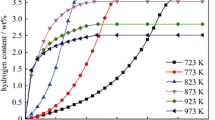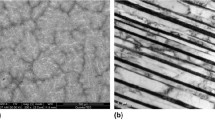A study of the impact of service factors on Ti-6Al-4V alloy hydrogenation at temperatures close to climatic is performed on the example of a failed hydrogen compressor. It is established that under high gas pressure conditions and possible metal heating hydrogen saturation of Ti-6Al-4V alloy can reach significant values that surpass those acceptable by one to two orders of magnitude. Hydride phases are determined in the alloy by X-ray phase analysis. Temperature programmed desorption provides identification of phase transitions occurring during hydrogen evolution from the metal.




Similar content being viewed by others
References
A. A. Il’in, B. A. Kolachev, and I. S. Pol’kin, Titanium Alloys. Properties, Structure. Composition VILS-MATI, Moscow (2009).
B. A. Kolachev, Metal Hydrogen Brittleness, Metallurgiya, Moscow (1985).
D. Eliezer, E. Tal-Gutelmacher, C. E. Cross, and T. Boellinghaus, “Hydrogen absorption and desorption in a duplex annealed Ti-6Al-4V alloy during exposure to different hydrogen-containing environment,” Material Science and Engineering, 433, No. 1-2, 298–304 (2006).
GOSТ 19807. Wrought Titanium and Alloys. Grades.
RMI Titanium Company. Titanium alloy guide. RTI International Metals: Inc. Company (2000).
N. F. Anoshkin, A. F. Belov, S. G. Glazunov, et al. (editors) Titanium Alloy Metallography, Metallurgiya, Moscow (1980).
A. I. Dekhtyar, O. M. Ivasishin, D. I. Kovalev, et al., “Features of formation during controlled hydrogenation and dehydrogenation of titanium by different methods,” Metal. Noveish. Tekhnologii, 36, No. 9, 1153–1169 (2014).
E. A. Evard, I. E. Gabis, and A. P. Voyt, “Study of the kinetics of hydrogen sorption and desorption from titanium,” Abstract Journal of Alloys and Compounds, 404–406, 335–338 (2005).
M. Mingwang, L. Li, W. Lei, et al., “Phase transformations of titanium hydride in thermal desorption process with different heating rates,” International Journal of Hydrogen Energy, 40, 8926–8934 (2015).
M. Mingwang, W. Lei, T. Binghua, et al., “Kinetics of hydrogen desorption from titanium hydride under isothermal conditions,” International Journal of Hydrogen Energy, 43, 1577–1586 (2018).
N. R. Kudinova, V. A. Polyanskii, A. M. Polyanskii, and Yu. A. Yakovlev, “Determination of dissolved hydrogen bond energy on the basis of a model of multiple diffusion in a solid,” Nauch-Tekhn. Vedom. SPbGTU. Fiz.Mat.nauki, 4(230), 9–23 (2015).
Author information
Authors and Affiliations
Corresponding author
Additional information
Translated from Khimicheskoe i Neftegazovoe Mashinostroenie, Vol. 56, No. 8, pp. 45–48, August, 2020.
Rights and permissions
About this article
Cite this article
Dobrotvorskii, M.A., Shevyakova, E.P., Simanov, M.A. et al. Effect of Operating Factors on Ti-6Al-4V Titanium Alloy Hydrogenation Close to Climatic Temperatures. Chem Petrol Eng 56, 681–687 (2020). https://doi.org/10.1007/s10556-020-00826-4
Published:
Issue Date:
DOI: https://doi.org/10.1007/s10556-020-00826-4




